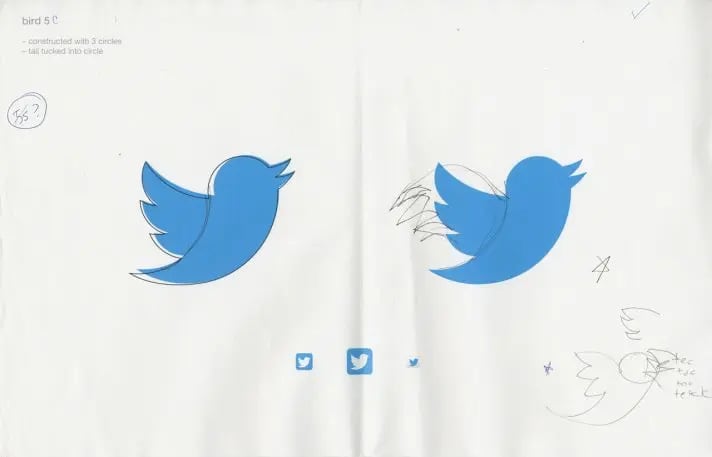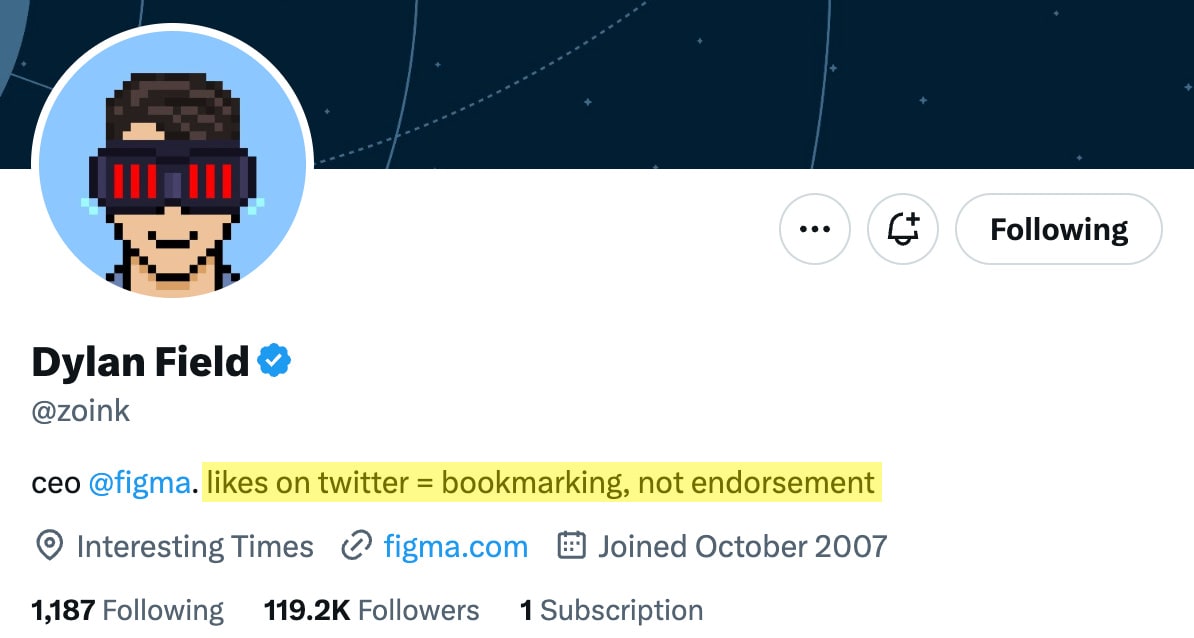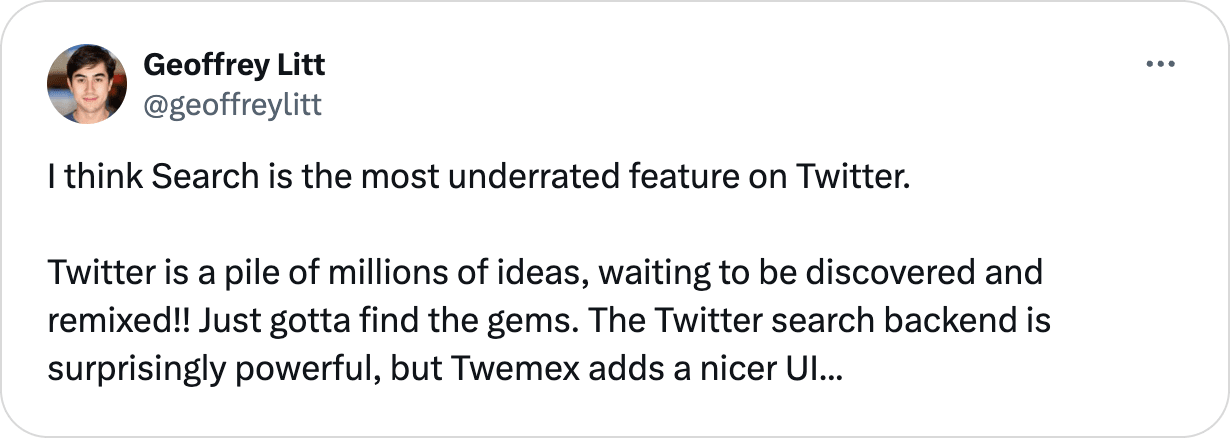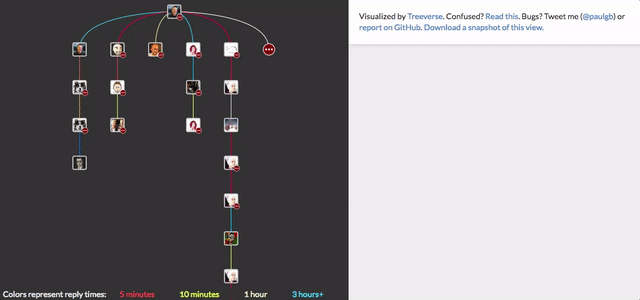The losing identity of Twitter
post by Itay Dreyfus (itay-dreyfus) · 2024-04-21T13:43:15.145Z · LW · GW · 1 commentsThis is a link post for https://productidentity.co/p/6-twitter-whats-my-name-again
Contents
The subculture of singing birds The Agora is crowded, but it has a place for everyone. Identity on the verge Short-long form Not a bloatware empire Mechanism of design As a tool for thinking If Roam has backlinks, and Notion has databases, then Twitter has Threads. In Twitter’s playground None 1 comment
What’s Twitter for you?
That's a long-lasting trend I often see on my feed when people praise the blue bird for getting them a job, introducing them to new people, investors, and all this and that.
What about me? I just wanted to get into dribbble — the then invite-only designer's social network which was at its peak at the time. When I realized invites were given away on Twitter, I set up an account and went on a hunt. Soon, the mission was accomplished.
For the next few years, I went on a radio silence. Like many others, I was lurking most of the time. Even today I don't tweet excessively. But Twitter has always been a town square of mine. Suited best for my interests, it’s been a place for belonging to Design and Tech Twitter for many years.
It feels a bit intimidating to write about Twitter. I don’t have a badge of honor representing my high social graph—my reach is barely going places. But as another person who consistently addictively checks Twitter many times during the day, it’s an exciting Pandora’s box to open. And despite all the recent noise since Elon’s takeover, I still view Twitter as a novel product. Like many others, I get horrified by some tweets from Elon’s gang, but luckily this isn't another (or at least a full) ranting post about the upcoming "death" of Twitter.
My hot take is an old one: Twitter is one of the most intellectual places on the internet. Sure, it’s also a fertile ground for toxicity to spread, but as a theme for this post, I choose to embrace
Nabeel S. Qureshi serendipity approach:
But a well-curated Twitter feed is worth a lot of IQ points -- so I think it's worth doing.
Old Duck Twitter has been endowed with a special community and unusual design. It has been wearing many hats throughout the years. Although some cracks in its identity have arguably started to emerge, it’s still the king of short-form messages, capturing words of wisdom into bite-sized tweets.
The subculture of singing birds
Twitter is the most mainstream and niche place both at the same time, as counterintuitive as it may sound.
To put it adequately, I like how the team of Metalabel framed the crypto scene:
Crypto is a subculture. A self-contained universe, and a relatively small one.
Twitterverse has been forever understood only by its loyal citizens. And like in any subculture, it has developed its own unique language—an odd style of writing characterized by cynicism, rantings, and coaching rhetorics. The nuances, atmosphere, and vibes of Twitter are inexplicable to outsiders. In fact, it’s often perceived as a big black hole for newcomers. Again, a line can be drawn from Metabel’s crypto writing:
When crypto people interact with non-crypto people, the degree of devotion is especially stark.
But unlike in crypto, where most people are tech-savvy or idealists who share strong beliefs, the subculture of Twitter is more about “strong beliefs loosely held”.
It’s a diverse place as colorful as a rainbow: geeks, politicians, celebrities, provocateurs, and modern philosophers gather in a weird blend. Some come to debate fiercely, others lurk for insights, and some promote their products or services.
We all knew that we were going to change the world with this thing that no one else understood.
How Twitter Was Born, Dom Sagolla
What keeps Twitter still distinct after so many years? To me, it’s a mixture of its mechanics (which will be discussed later) and the subculture itself:
- A unique style of writing
- A text-first medium
- A channel for direct, two-side communication
Social networks come and go, serving as small Agoras for different niches and topics. But Twitter succeeded in creating the main modern Agora where everyone can come and share their perspectives and musings with whoever’s willing to listen.
The barriers are small to participate in this Agora—there’s no need for an invite, or permission to join a discussion. Sometimes I find myself surrounded by some meta-tweets of lateral thinkers, which I’m trying hard to understand, or by some gurus spreading “insightful” threads.
The Agora is crowded, but it has a place for everyone.
There are times I get frustrated, wishing my feed would display some more high-quality-better-intellectual content, but my overall sentiment for Twitter is positive.
Identity on the verge
For nearly two decades the blue bird has dominated the medium of short-form text on the internet. Moreover, it shaped it. As a platform born from the SMS era's remnants, Twitter nurtured the form of short messages in its unique style. It seems birds prefer brevity in their conversations.
Although being a wasp nest for whatever you can think of—it oddly embodies the kind of serendipity I mentioned in the intro. It’s undeniably a home for public fights, brutalism, and harsh critique, but it always felt like a cosmic place. In the middle of all this mess, I could always find interesting discussions, discover products, and learn about new ideas.
In Twitter's previous life, there was Larry the Bird (Twitter’s logo, which itself has an interesting story), and an amusing lingo that has symbolized Twitter’s serendipity to me. MG Siegler's nostalgic analogy is a charming one in this regard:
You may not think of Twitter being just like a postcard, but in some ways it is — one that you can instantaneously send to many friends or acquaintances at the same time. And minus the cost of a stamp.

Even if Twitter wanted to cover up its appearance with blueness and cuteness, I couldn’t ignore the atmosphere its branding induced.
It’s been almost 2 years since the acquisition and Elon isn’t afraid to slaughter sacred cows, if someone needs proof at all. The launch of a new revshare (creator) program and premium model might meant to make Twitter more meaningful to the community while paying them back. Although it’s based on ad exposure in replies, I agree with the general idea of rewarding people rather than “using” them. Also, the new premium business model allows Twitter to become more sustainable which is rare in today’s online economy.
But for other decisions, there might be more profound effects.
The decision to turn Twitter into X, from a branding aspect, turned serendipity into an undesired black hole. The newly grungy icon conveys the exact opposite to me. The thinking behind the "X" symbol could be anything. However, as elevated as it may be I can't tell any positiveness from looking at a broken glass. Weirdly or not, the new X icon sitting on my screen arouses “evil corp” vibes within me.

Larry was like the singing bird I heard from my window while writing these words. I’m not sure what X is.
Short-long form
Despite my emotional stance, the X mini-branding isn't the primary concern. Well, many refuse to call it X, but after having a good 16-year run, for better and worse—the backbone of Twitter’s product has been forever changed with the recent addition of longform features.
The quirky format of squeezing thoughts into a short 140-then-280-character message was Twitter’s identity in many ways. However, premium subscribers can now go up to 4,000 long tweet characters. To a great degree, this “improvement” has made Twitter brandless.
Moreover, if you've been paying attention lately, you might have noticed that publishing articles have arrived on Twitter too. So now paying subscribers can also write and publish Medium-style articles with some styling and formatting options.
Has the magic disappeared? Is the medium dead? I think it’s somewhat ruined.
A few years ago Venkatesh Rao wrote that online text as a medium “is eating the world”, claiming the thread phenomenon is the most interesting one. Threaded Twitter isn't dead (yet) but what Rao might have predicted has gone the "wrong" half:
"There’s a 50-50 chance they will do something boneheaded to mess up the potential"
Twitter was born and still lives in the medium of text. The ability to write longer tweets might make it easier to hit the publish button. It eliminates the cognitive burden of breaking the head over how to condense a tweet, but that’s the magic of threading, and tweeting in general.
The rules of Twitter’s garden are changing. Like with external links, the algorithm may favor longform tweets and deprioritize threads. Although I don’t think threads will vanish very soon, this could mark the start of a new phase for Twitter.
Not a bloatware empire
Twitter has been in the game for a long time. It became a gigantic company, went public, and then private again. But despite its enormous timeline, its voice remained distinct, unlike most of Big Tech. The capitalistic "hyper-growth” mode invectives companies becoming bloated corporate empires:
Facebook was born out of private messages, then added a news feed, and in-app games, then expanded to communities, photos (Instagram), instant messaging (WhatsApp), and whatnot. It even has been involved in building an internet infrastructure in Africa.
Google started as a search engine then went into building an ads platform, then launched Gmail, an operating system, invested in satellites for their maps platform, and so on. According to Google’s graveyard of products, 293 products were sunsetted over the years.
You know the drill—that's the world we live in.
Twitter isn’t innocent. It experimented with other online mediums like video and audio when it acquired Vine, and Periscope, or launched audio features like voice tweets and live spaces. But unlike other incumbents, Twitter somehow remained loyal to its roots. It even waited a long decade to increase its character limit for the first time.
Some could argue the need to expand and build an empire but to me, Twitter has been rare in the landscape of tech empires, preserving a sense of authenticity. It’s hard to think of a multi-billion-dollar company that owns a product with a relatively small set of features.
But the new articles feature could be a symptom. Alongside other whims like “a video-first platform”, Grok, and “the everything app”, Twitter might become a bloated platform in the name of corporate-ism, which already flocked many people away.
Mechanism of design
There's an old-ish concept in product design, which might be known by a more popular name called Why Mechanics Design. It was published by David Cole, former Quora's VP of Design, explaining his team’s doctrine when developing a product:
They are more like the rules of the product, conscious choices towards a desired behavioral end. This class of decisions is what our design team has termed mechanics design.
I like to think of a product’s mechanics as the leeway on which a product should act and perform. You can only go as far as in the boundaries you set.
In a follow-up post, Cole puts the concept into practice by analyzing Twitter's mechanics, describing the components that were driving Twitter's growth on the road to accomplishing its mission.
However, it’s been 8 years since the post was published, which is fairly old—especially in the lifespan of a startup. A few mechanics like Retweets, the character limit, and @mentions have survived the hardships of time while other features like Periscope live streams and Moments didn’t.
If I were to write another follow-up, I’d add bookmarks to the updated list. Although bookmarking as a feature isn't being leveraged or best utilized to some opinions, it has become a prominent mechanic in Twitter's postmodernism experience.
Engaging on Twitter is primarily a public activity. Likes, replies, and retweets are all shared in the subjectively collective feed. All of the mechanics outcomes are available to others. People's activity on the platform reflects their interests and whoever engages with their tweets “reveals” his identity. Or as in Dylan Field bio:

But since bookmarks were launched, Twitter got a bit of an intimate characteristic. There’s something in bookmarked tweets that makes them feel special while establishing a weird relationship between the OP (or OT?) and the engaging profiles.
Hitting the bookmark icon makes a tweet more special, as it’s being sent to a private, personal folder, waiting to be reminded or revisited. The anonymity of bookmarkers adds depth to a tweet, making it more meaningful.
When I see a highly bookmarked tweet, sometimes more than it was liked, I get the signal of a particular interesting content that’s worth watching, following—or even better, bookmarking.
Curation is a powerful practice that might be underrated to some degree, but in my opinion, bookmarking on Twitter still has a lot of untapped potential and room to grow. The bookmarks folder serves as a library of gems—what could be revealed if your highly curated tweets were available to others? There might be a whole new world of feeds to discover.
As a tool for thinking
Through the hype of Roam Research I first learned about Tools for Thought (known as TfT)—a concept usually refers to tools that encourage deep thinking.
In the past few years or so, TfT has become widely known in the productivity space. PKMs, note-taking, and network thought tools like Notion, Roam, and Obsidian have made their debut as TfT became a movement with die-hard fans.
But unlike most tools, Twitter isn’t a tool per se. Nor was it built to help people explicitly save or organize notes. To most, Twitter is rightly seen as a traditional social network. In this context, I like how Alan Kay defines a tool for thought:
A truly new medium [where] the very use of it would change the thought patterns of an entire civilization
Alan Kay – User Interface: A Personal View (1989) via Maggie Appleton: Tools for Thought as Cultural Practices, not Computational Objects
Observing Kay's articulation really echoes Twitter's raison d’être. And as much as I’m not fond of fancy mission statements, Twitter's official one (or at least what it used to be) is somewhat down-to-earth:
Twitter's mission is to give everyone the power to create and share ideas and information instantly without barriers.
Why Twitter’s Mission Statement Matters, Justin Fox
To put that statement to a test, we can say that Twitter has become a new medium of itself. Tweeting has transformed into a culture and a mode of online interaction. That’s quite an achievement.
But it’s interesting to observe Twitter as a tool for thought. It might evolved to become one due to its native’s creativity, completely by accident. As with any other so-called tool for thought, there’s got to be a special mechanism that enables its magic.
If Roam has backlinks, and Notion has databases, then Twitter has Threads.
What started as a hack to bypass the character restriction has become a form of micro-blogging, enabling people to tell longer stories, and creating branches of interconnected topics.
For the masses, Twitter has become a place to “fart״ ideas and thoughts—often raw and unfiltered. But for a very few people, Twitter has become some sort of a public diary, largely because of the extensive use of Threads—a practice which to them became a form of art. Some might call it Memexing, or a canvas for writing and sketching ideas:
Maxim Leyzerovich (@round) has been memorizing tweets as images. He’s rigorously threading tweets of himself and others, which often seems like a note to self. He tends to revisit old tweets and extend them with further ideas and concepts—which creates an interesting timeline across the years.
Visa (@visakanv) might be the godfather of Threaded Twitter. By amassing more than 250k tweets, his feed looks like a public second brain, which serves as an inspiration for many. Through his distinctive style, Visa explores and develops ideas over time in almost any field. He even published a book out of his threads (of course he also made a testimonial thread). Visa’s habit of revisiting his own tweets and “updating” them with new findings, makes him the biggest retweeter of himself as Eli Parra once tweeted.
Ventakesh Rao (@vgr) is a well-known consultant-researcher-theorist-blogger. He has partially departed Twitter but as a former avid tweeter, he prompted the idea of Threadpalloza: a challenge to make 100-long tweet threads on any topic. The experiment went above and beyond, exploring various ways a thread can go.
The beauty of Threads is that it’s just a set of continuous tweets. It’s the same component, just assembled linearly. To a large extent, Threads have deepened Twitter’s content—a good thread can be a great source of information.
Using Twitter as a way for critical thinking probably belongs to the 0.01% but its social layer applies to all. It can become your own search engine, knowledge base, and guestbook altogether.
In Twitter’s playground
Besides Twitter's cultural effect, there has been another interesting phenomenon that has developed over the years.
Possibly because of its incapacity to extend its features further, a deliberate decision, or another underlying reason, Twitter has left some of its core parts unutilized. But its developer-oriented user base has found the way, thanks to the (old) API free access, to build their ideas on top of Twitter’s platform. From early on, enthusiasts realized the hidden potential in Twitterverse and started filling the gap.
To demonstrate its rich tooling community, here are some distinguishable examples:
Tweetdeck. In 2008 the app was launched to help people unify their social feeds in one place. After gaining massive success, it was acquired by Twitter and became solely a Twitter client. By customizing query-based feeds and displaying them side by side, people can follow their interests and cut through the usual experience noise.
Typefully. The lack of proper draft support yielded the well-known webapp. As the “creator economy” hit Twitter, many have started to plan, organize, and optimize their tweets. Twitter’s drafts system is (still) no more than an unintuitive tab, to say the least. I encountered pain many times when I was typing a long thread only to discover that an error had occurred and my effort went down the drain after I hit publish. The app has been built as a standalone app which removed that hassle, allowing people to write drafts with peace of mind—outside of Twitter’s interface. Since it was launched, the indie app found a loyal audience and expanded to more platforms and features.
Tweemex. This is probably my favorite. Twitter has built an extremely useful product that has become an important information hub for many. However, searching on Twitter is cumbersome. Although having built an advanced search mode, with lots of operands, it isn’t widely known. This is where Twemex comes in. Over the years I discovered Twitter as a better search engine than Google in many ways. The authentic, unpromoted content created by real humans made me rely on Twitter often whenever I’m researching different topics. Twemex leverages the advanced search functionality while making it accessible. Serendipity occurs in random ways, but using Twemex increases such moments.

Threader. Another app that was acquired by Twitter itself. As a read-it-later app, Threader enabled people to save threads directly from Twitter and see them in one longform piece. Tweeters could also discover new threads within the app, enriching content discovery beyond Twitter itself.
Other niche tools and experiments. By now, I should have become familiar with the threads UX. But apparently, I'm not the only one who doesn’t. Paul Butler has built a little cool extension called Treeverse that turned any thread into a tree view—allowing people to explore thread branchings visually while keeping context, which tends to get lost in the original thread interface.

In addition, I particularly like Eli Parra’s experiments. His explorations surface food for thought for how to navigate through dense threads while presenting interesting solutions. Here’s Naval’s most famous(?) How to Get Rich (without getting lucky) thread at one glance.
However, Twitter’s playground has shrunk after it removed the free API tier and announced new pricey plans. Many small-indie apps like Small World were impacted and ultimately were killed due to this decision. The above-mentioned Treeverse was affected as well and has been retired.
For developers, the API storm demonstrates the risk of building on top of a platform, and for Elon, it might mean that the party is over. No more free or cheap rides. But the playground of Twitter was a unique place for creativity to spark. Twitter served as a source of inspiration, making people follow their curiosity. I don’t know whether this whole saga is a financially better decision. On the one hand, there are no more “free meals” but on the other hand, it means declining in the ecosystem which made many indie developers solid revenue streams, while cultivating a thriving community.
1 comments
Comments sorted by top scores.
comment by lesswronguser123 (fallcheetah7373) · 2024-04-23T06:15:18.897Z · LW(p) · GW(p)
Ever since they killed (or made it harder to host) nitter,rss,guest accounts etc. Twitter has been out of my life for the better. I find the twitter UX in terms of performance, chronological posts, subscriptions to be sub-optimal. If I do create an account my "home" feed has too much ingroup v/s outgroup kind of content (even within tech enthusiasts circle thanks to the AI safety vs e/acc debate etc), verified users are over-represented by design but it buries the good posts from non-verified. Elon is trying wayy too hard to prevent AI web scrapers ruining my workflow .